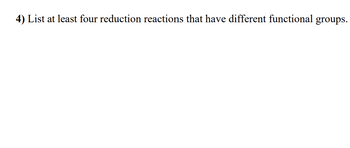
Chemistry: Matter and Change
1st Edition
ISBN: 9780078746376
Author: Dinah Zike, Laurel Dingrando, Nicholas Hainen, Cheryl Wistrom
Publisher: Glencoe/McGraw-Hill School Pub Co
expand_more
expand_more
format_list_bulleted
Question

Transcribed Image Text:4) List at least four reduction reactions that have different functional groups.
Expert Solution
This question has been solved!
Explore an expertly crafted, step-by-step solution for a thorough understanding of key concepts.
This is a popular solution
Trending nowThis is a popular solution!
Step by stepSolved in 1 steps

Knowledge Booster
Similar questions
- 3. What happen during redox, dehydration, hydration and decarboxylic reaction? Give examples of each of the reaction.arrow_forwardWhat are synthetic reactions in organic chemistry?arrow_forwardPlease help me check if the information below is correct for both the types of reactions and the special rules or laws to predict predominant products for alcohols. If not please insert the correct information. Please make the information in jot notes. TYPES OF REACTIONS ALCOHOL: Dehydration: This is a reaction where an alcohol loses a water molecule to form an alkene. For example, when ethanol is treated with an acidic catalyst, such as sulfuric acid, it undergoes dehydration to form ethene (CH2=CH2) and water. Oxidation: In this reaction, an alcohol is converted to either a carbonyl compound or a carboxylic acid. For example, primary alcohols can be oxidized to aldehydes or carboxylic acids, while secondary alcohols can be oxidized to ketones. Tertiary alcohols are not oxidized under normal conditions. Esterification: This reaction involves the formation of an ester from an alcohol and a carboxylic acid in the presence of an acid catalyst. For example, when ethanol is…arrow_forward
- 4) When determining the oxidation state of carbon in an organic molecule, each hydrogen bonded to carbon decreases the oxidation state of carbon by 1 and each oxygen bond to carbon increases the oxidation state of carbon by 1. Using this information, determine the oxidation state of the benzylic carbon in toluene and the carbonyl carbon in benzoic acid. For example, in H3C-CH2-OH the CH₂ carbon has an oxidation state of 0-2+1 = -1.arrow_forward1. Write the overall reaction for an El reaction or the dehydration of an alcohol.arrow_forwardEncircle the functional groups, label each functional group with a letter, and identify the type or class of compounds represented by each functional group. 1. LSD, a hallucinogenic drug widely believed to be the inspiration behind the Beatles hit “Lucy in the Sky with Diamonds” 2. Methyljasmonate, a compound that belongs to a group called the pheromones. The male oriental fruit moth, Grapholitha molesta Busk., responds when a female moth emits this compound. 3.arrow_forward
- Ethanol, C2H5OH, and propane, C3H8, have approximately the same molar mass, yet ethanol has a much higher boiling point. Briefly explain why. Ethanol, C2H5OH, and dimethyl ether, CH3OCH3, have the same molar mass, yet ethanol has a much higher boiling point. Briefly explain why. Write an equation to show the reaction between ethanol, C2H5OH and methyllithium, CH3Li. Draw all non-bonding electrons and show electron flow with curved arrows. 37. Write an equation that shows the reaction between acetic acid (CH3COOH) and triethylamine (CH3CH2)3N. Draw all non-bonding lone electron pairs and show the electron flow with curved arrows.arrow_forwardОН 1. CH3MgCl 2. H3O+ A + B (2 organic products)arrow_forward8) Arrange these compounds in order of increasing boiling point. I. 1-butanol II. butanal III. A) Iarrow_forward
- Hydrocarbons like benzene are metabolized in the body to arene oxides, which rearrange to form phenols. This is an example of a general process in the body, in which an unwanted compound (benzene) is converted to a more water-soluble derivative called a metabolite, so that it can be excreted more readily from the body. a.) Classify each of these reactions as oxidation, reduction, or neither.b.) Explain why phenol is more water soluble than benzene. This means that phenol dissolves in urine, which is largely water, to a greater extent than benzenearrow_forwardClick the "draw structure" button to launch the drawing utility. The following reaction has been reported in the chemical literature. Write the structure of the product(s) formed. & H3C CH3 1. Diethyl ether 2. H₂O I I I I draw structure ... Iarrow_forwardWhat are the special rules or laws to predict predominant products of alcohol and ether (organic chemistry)arrow_forward
arrow_back_ios
SEE MORE QUESTIONS
arrow_forward_ios
Recommended textbooks for you
- Chemistry: Matter and ChangeChemistryISBN:9780078746376Author:Dinah Zike, Laurel Dingrando, Nicholas Hainen, Cheryl WistromPublisher:Glencoe/McGraw-Hill School Pub Co
 Organic Chemistry: A Guided InquiryChemistryISBN:9780618974122Author:Andrei StraumanisPublisher:Cengage Learning
Organic Chemistry: A Guided InquiryChemistryISBN:9780618974122Author:Andrei StraumanisPublisher:Cengage Learning

Chemistry: Matter and Change
Chemistry
ISBN:9780078746376
Author:Dinah Zike, Laurel Dingrando, Nicholas Hainen, Cheryl Wistrom
Publisher:Glencoe/McGraw-Hill School Pub Co

Organic Chemistry: A Guided Inquiry
Chemistry
ISBN:9780618974122
Author:Andrei Straumanis
Publisher:Cengage Learning